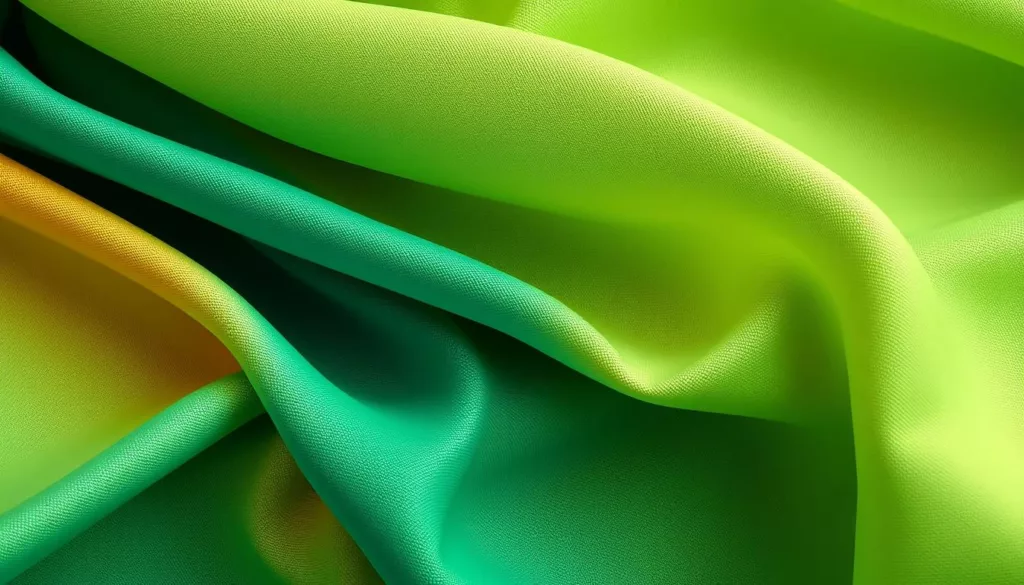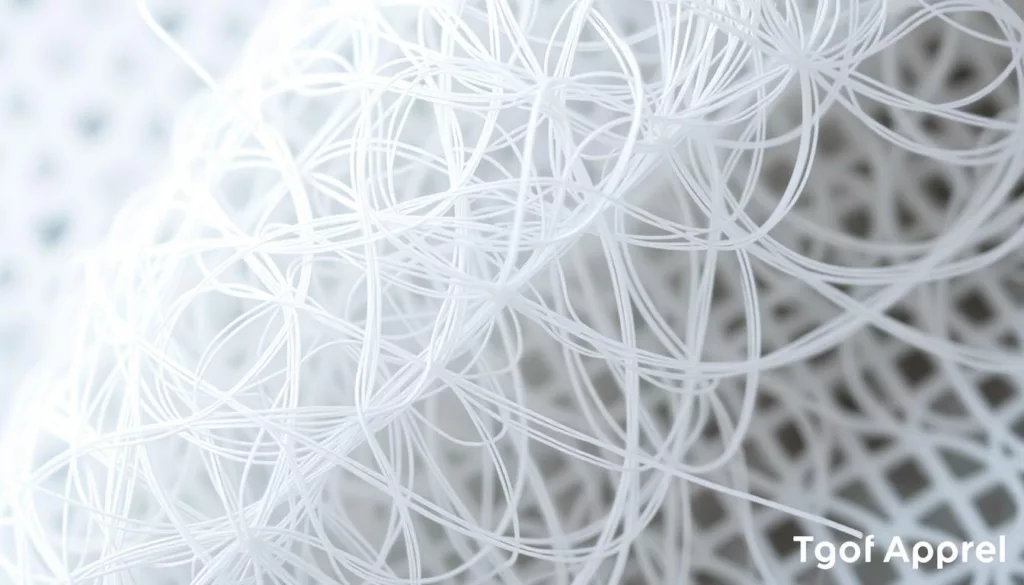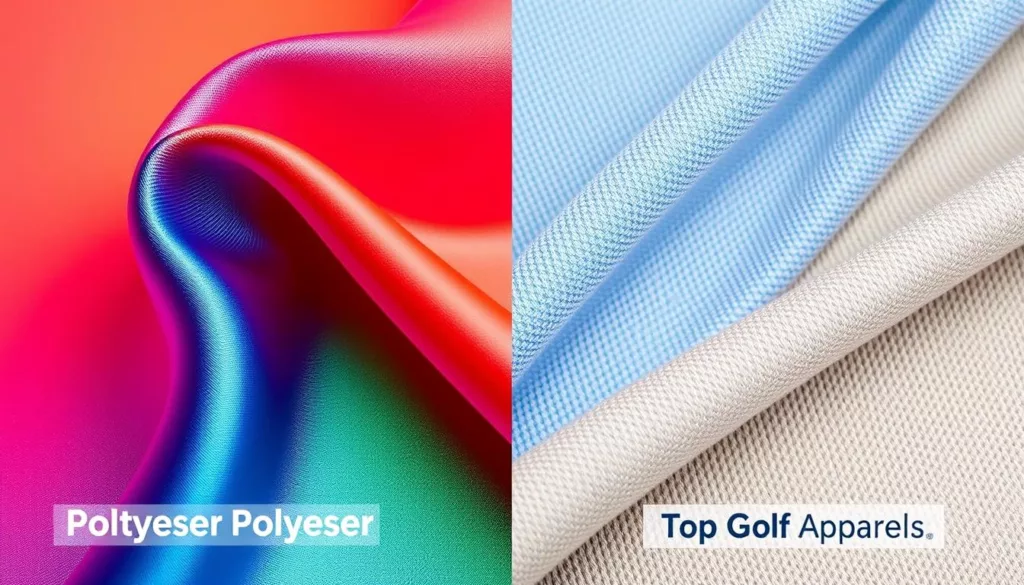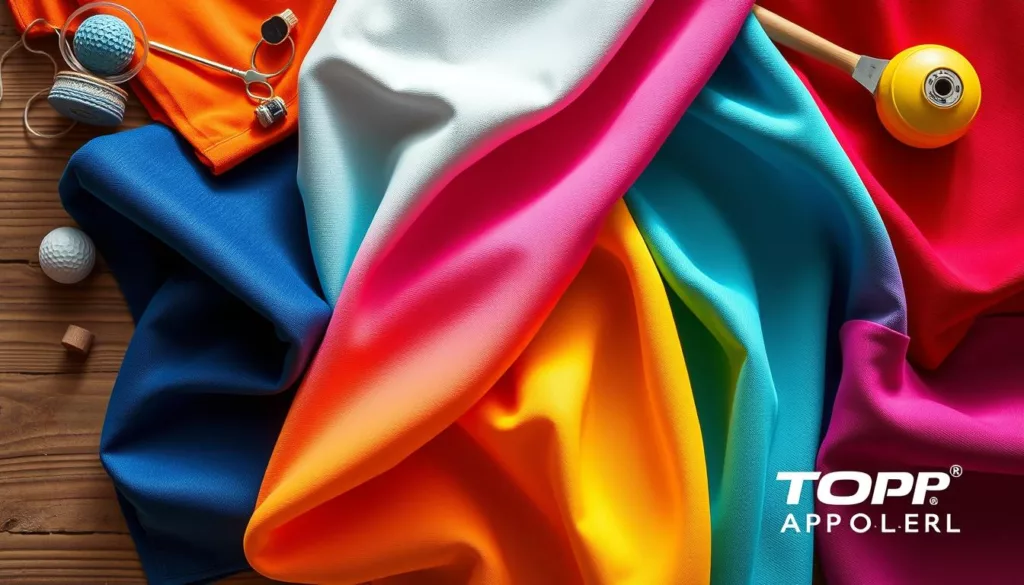Polyester fabric is everywhere, from clothes to home decor. It’s known for being tough and drying fast. This makes it very useful in many fields. A big question is, does polyester shrink? The answer is mostly no, which is great for everyday and special use items.
Polyester is also loved for being affordable. It’s made from petroleum and has changed a lot over the years. It doesn’t wrinkle easily and keeps colors bright, making it perfect for things that need to look good with little effort.
In sports clothes, like polo shirts and shorts, polyester really stands out. It’s a top choice for sports because it’s both comfy and performs well. Learn more about polyester in sports, like in golf trousers and other sports equipment.
Key Takeaways
- Durability and moisture-wicking properties contribute to the versatility of polyester fabric.
- Polyester rarely shrinks, making it great for everyday and special use items.
- The fabric resists wrinkles and retains color, perfect for easy-care clothes.
- Cost-effectiveness makes polyester a popular choice across various industries.
- From fashion to sportswear, polyester’s adaptability is unmatched.
What is Polyester?
Polyester is a very common synthetic fiber used all over the world. To understand its value, we need to know where it comes from and what makes it special. It’s a key player in many industries.
Definition and Origin
The polyester definition points to a group of polymers made from terephthalic acid and ethylene glycol. These elements create a strong and flexible material. People often wonder, what is polyester made of? It’s made from petroleum-based chemicals. This process makes polyester strong and resistant to shrinking and stretching.
History of Polyester Fabric
The story of polyester began in the early 1940s with British chemists John Rex Whinfield and James Tennant Dickson. Over time, it became very popular, mainly after World War II. By the 1970s, polyester was a big hit in the textile world. It’s known for drying quickly and not wrinkling easily.
Polyester Material
Polyester fabric is very popular because it’s durable and versatile. It’s used in many things, like clothes and home items. This part talks about what polyester is made of and the different kinds available.
Chemical Composition
The chemical composition of polyester comes from ethylene glycol and terephthalic acid. This makes strong, long chains that last a long time. Polyester doesn’t shrink, stretch, or wrinkle much because of its special chemical makeup.

This makes polyester great for clothes because it lasts long and is easy to care for. For more on using polyester for golf clothes, check out our customization services.
Types of Polyester Fabrics
There are many types of polyester fabrics, each with its own special features:
- Polyethylene Terephthalate (PET): This is the most common type, known for being strong and versatile. PET is used in sports clothes, outerwear, and home items.
- Polyester Fleece: It’s warm and soft, perfect for jackets and sweaters. It keeps you warm well.
- Microfiber: This is a finer polyester, used in cleaning cloths, medical stuff, and fancy clothes. It’s soft and absorbs a lot.
- Polyester Satin: It has a shiny surface and is smooth. It’s used in fancy dresses, blouses, and linings.
The many types of polyester fabrics meet all kinds of needs. From sports clothes to fancy dresses, knowing about polyester helps pick the right fabric. This ensures the best performance and happiness.
Polyester Structure
The polyester structure is a marvel of modern textile engineering. It makes durable and versatile materials. This section explores the polyester fiber structure and how it’s made.
Fiber Structure
The polyester fiber structure comes from synthetic polymers. It’s made through polymerization. Polyester fibers are long chains of esters, from alcohol and organic acids.
These chains are spun into fibers. They show high strength, elasticity, and resistance to abrasion. Knowing how polyester fibers are made helps us see why it’s used in many things, from clothes to industrial products.

The microstructure of polyester fibers gives it many good properties. The tightly packed ester chains make it hydrophobic, resisting water and stains. The crystalline regions in the fibers also boost its tensile strength, making it durable under stress.
The way molecules are arranged in the polyester structure is key to its functions.
Manufacturing Process
Manufacturing polyester fabric involves several important steps. First, raw materials are turned into polyethylene terephthalate (PET) through polymerization. This is done by reacting ethylene glycol and terephthalic acid.
Then, the PET is melted and extruded into fine filaments. After that, the filaments are stretched to align the molecular chains and increase strength. The fibers are then crimped to make them bulkier and more textured.
Spinning these fibers into yarns and weaving or knitting them into fabric is the final step. This completes the manufacturing polyester fabric process, giving the material its final form and properties.
This process shows why polyester is so versatile and resilient. It’s a key part of modern textile manufacturing.
| Stage | Description |
|---|---|
| Polymerization | Chemical reaction between ethylene glycol and terephthalic acid to create PET. |
| Extrusion | Melting and forming PET into continuous filaments. |
| Drawing | Stretching the filaments to align molecular chains. |
| Crimping | Introducing texture and bulk to the fibers. |
| Spinning | Turning fibers into yarn. |
| Weaving/Knitting | Forming yarns into fabric. |
Polyester vs Cotton
Choosing fabrics for golf clothes often leads to a debate between polyester vs cotton. Both have their own benefits and drawbacks. It’s important to consider durability, how well they handle moisture, and their environmental impact.
Durability Comparison
Polyester is more durable than cotton because it’s made of synthetic materials. It doesn’t stretch, shrink, or wear out easily. Cotton, while comfy, doesn’t last as long and can get worn out faster. This makes polyester great for active wear that needs to last.
Moisture-Wicking Properties
Polyester is known for its ability to wick away moisture. It helps sweat evaporate quickly, keeping you dry and comfy. Cotton, on the other hand, absorbs moisture, which can cause discomfort and irritation. For golf clothes, polyester’s moisture-wicking properties are a big plus.
Environmental Impact
Looking at polyester vs cotton from an environmental standpoint is key. Cotton is natural and has a lower carbon footprint at first. But it uses a lot of water and pesticides, which isn’t good for the planet. Polyester, while made from synthetic materials, can be recycled, reducing waste. This balance is changing as more sustainable and recycled polyester options become available.

| Aspect | Polyester | Cotton |
|---|---|---|
| Durability | High | Moderate |
| Moisture-Wicking | Excellent | Poor |
| Environmental Impact | Can be recycled | High water/pesticide use |
Polyester Properties
Polyester fabric is known for its amazing qualities. It’s a favorite in many fields, like making high-quality golf vests. Its strength, resilience, and color retention make it very useful.

Strength and Resilience
Polyester is incredibly strong. It can handle a lot of force without breaking. This makes it very durable.
It keeps its shape and structure even after many washes. This is key for things like golf vests, which need to last through tough play.
Color Retention and Fade Resistance
Polyester also keeps colors bright for a long time. It doesn’t fade easily, even when exposed to sunlight and washing. This is great for golf clothes, keeping players looking good.
For more on customizing golf vests, check out golf vest manufacturers.
Care and Maintenance
Looking after polyester clothes is easy but important. Wash them in cold water with a mild detergent. Don’t dry them on high heat, as it can harm the fabric.
By following these tips, your polyester clothes will stay in great shape. They’ll keep you comfortable and stylish for a long time.
| Property | Benefit |
|---|---|
| Strength | Maintains shape even after multiple washes |
| Color Retention | Vibrant colors last longer, reducing fade |
| Care | Simple washing and drying practices |
Types of Golf Apparel Made from Polyester Fiber
Polyester golf apparel is loved by many golfers. It’s flexible, durable, and wicks away moisture. This makes it great for all kinds of golf and weather.
Polyester Polo Shirts
Polyester polo shirts are a favorite in golf. They breathe well and dry fast, keeping you comfy. They also last long, looking good even after many washes. Learn more about the benefits of different fabrics in golf.
Polyester Shorts and Pants
Polyester shorts and pants are light and stretchy. They let you move freely. They also keep you dry with their moisture-wicking tech. Plus, they resist wrinkles and fading, keeping you looking sharp.
Polyester T-Shirts
Polyester t shirts bring a fresh look to golf. They’re comfy and flexible, perfect for a good swing. They wick away sweat, keeping you cool. Plus, they’re soft, so you won’t get irritated.

Polyester Hoodies
Polyester hoodies are a hit with golfers. They’re stylish and keep you warm without being heavy. They dry fast, handling rain or sweat easily. They’re great for all-day wear.
Polyester Outerwear and Jackets
Polyester outerwear and jackets are essential for early or late games. They’re waterproof and warm. They’re also light, making them easy to carry.
Polyester golf apparel is a top choice for golfers. It combines style, comfort, and function perfectly.
Conclusion
Polyester fabric is a versatile and strong material in the textile world. We’ve learned about its chemical makeup, structure, and how it’s made. This shows why it’s a favorite for many uses.
It beats natural fabrics like cotton in many ways. Polyester lasts longer, wicks moisture better, and is kinder to the planet. This makes it a key player in today’s textiles.
Polyester’s strength, color hold, and easy care make it perfect for many things. It’s great for everyday shirts and top-notch sports clothes. It’s also reliable for outdoor gear like jackets and hoodies.
Looking ahead, polyester’s recyclability and eco-friendliness are big pluses. New ways to recycle and make it are coming. This means polyester could help make fashion more sustainable and useful in many areas.
FAQ
Does polyester shrink?
Polyester is known for its durability and resistance to shrinking. It keeps its shape and size when washed and dried normally. But, extreme heat can cause it to shrink slightly. So, it’s important to follow care instructions.
What is polyester made of?
Polyester is a synthetic fiber made from petroleum-based materials. It’s made from petrochemicals that are polymerized to form polyester resin. This resin is then melted and extruded to create fibers.
How does polyester compare to cotton?
Polyester and cotton are different. Polyester is more durable and less likely to shrink. It also has better moisture-wicking properties than cotton. Cotton, on the other hand, is breathable and soft but less durable and more prone to shrinking.
What are the types of polyester fabrics?
There are several types of polyester fabrics, including PET, PCDT, and microfiber. Each type has unique properties for different uses. PET is the most common type for apparel.
What are the benefits of polyester shirts?
Polyester shirts are durable and resistant to wrinkles. They also keep their color well. They are lightweight, quick-drying, and maintain their shape well. This makes them great for casual wear and active lifestyles.
Is polyester environmentally friendly?
The environmental impact of polyester is debated. Polyester is durable but its production is energy-intensive and relies on non-renewable petroleum resources. Advances in recycling technologies are helping to mitigate these concerns by allowing polyester to be reused and repurposed.
How should I care for polyester apparel?
Caring for polyester clothing is easy. It can be machine washed in warm water and tumble dried on a low setting. Avoid high heat to prevent shrinkage or deformation. Polyester also resists wrinkles, so ironing is usually not needed.
What makes polyester hoodies popular?
Polyester hoodies are popular for their durability, lightweight feel, and moisture-wicking properties. They offer comfort and warmth without being heavy. They are also resistant to shrinking and stretching, making them ideal for casual and active wear.
What is the difference between polyester and other synthetic fabrics?
Polyester differs from other synthetic fabrics like nylon and acrylic in its chemical composition and properties. Polyester is more resistant to UV degradation and doesn’t absorb moisture. Nylon is slightly stronger but more prone to yellowing and absorbing water. Each synthetic fiber offers unique benefits depending on the application.

